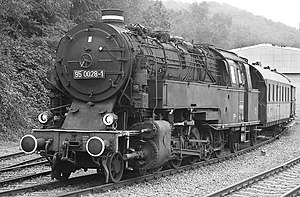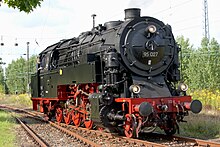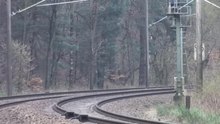DR series 95
| T 20 (Prussia) DR series 95 DR series 95.00 / 95.10 |
|
|---|---|
|
95 0028-1 in the Bochum Railway Museum
|
|
| Numbering: | DR 95 001-045 DB 95 001… 035 from 1970: DR 95 0004… 0045 or DR 95 1016… 1045 |
| Number: | 45 |
| Manufacturer: | Borsig , Hanomag |
| Year of construction (s): | 1922-1924 |
| Retirement: | 1958 (DB) 1981 (DR) |
| Type : | 1'E1 'h2 |
| Genre : | Gt 57.19 |
| Gauge : | 1435 mm ( standard gauge ) |
| Length over buffers: | 15,100 mm |
| Height: | 4,550 mm |
| Width: | 3,000 mm |
| Total wheelbase: | 11,900 mm |
| Smallest bef. Radius: | 300 m |
| Empty mass: | 103.7 t |
| Service mass: | 127.4 t |
| Friction mass: | 95.3 t |
| Wheel set mass : | 19.1 t |
| Top speed: | 65 km / h |
| Indexed performance : | 1,192 kW |
| Starting tractive effort: | ~ 254 kN |
| Driving wheel diameter: | 1,400 mm |
| Impeller diameter front: | 850 mm |
| Rear wheel diameter: | 850 mm |
| Control type : | Heusinger |
| Number of cylinders: | 2 |
| Cylinder diameter: | 700 mm |
| Piston stroke: | 660 mm |
| Boiler overpressure: | 14 bar |
| Number of heating pipes: | 218 |
| Number of smoke tubes: | 34 |
| Heating pipe length: | 4,500 mm |
| Grate area: | 4.36 m² |
| Radiant heating surface: | 17 m² |
| Tubular heating surface: | 181.81 m² |
| Superheater area : | 62.50 m² |
| Evaporation heating surface: | 198.81 m² |
| Water supply: | 12.0 m³ |
| Fuel supply: | 4 tons of coal |
| Brake: | Knorr pneumatic brake Riggenbach counter pressure brake |
| Train heating: | Steam heating |
The class 95 is a five- coupled tank locomotive with a 1'E1 ' wheel arrangement, which was put into operation by the Deutsche Reichsbahn (DR) from the beginning of 1923 for use in front of heavy freight trains on steep main lines . Since the development of the series began in the last days of the Prussian State Railways , it is also referred to as the Prussian T 20 according to the intended designation in the numbering scheme of the Prussian State Railways . It is one of the last new developments by the Reichsbahn before the standard steam locomotives were acquired .
history

With the development of the T 20, the Prussian State Railroad took up the idea of replacing the cumbersome and time-consuming rack- and- pinion railway operation on steep stretches with particularly powerful friction locomotives with dynamic counter-pressure brakes as the third braking system implemented by the Halberstadt-Blankenburg Railway with its animal class .
The first ten copies of the series built in 1922 at Borsig under chief designer August Meister and delivered from the beginning of 1923 had been ordered as T 20 Magdeburg 9201–9210. The vehicles were initially classified as 77 001 to 77 010 by the customer, as the 77 series was initially intended for them. In the course of the same year, however, they were renamed under the operating numbers 95 001-010. A total of 45 units were built by 1924. Applications included the railway Coburg-Ernstthal am Rennsteig , the railway Probstzella-Neuhaus am Rennweg , the Spessart ramp , the railway line Hochstadt-Marktzeuln-Probstzella that Geislingen , the inclined plane and the Rübelandbahn , causing them to her nickname "Queen of the Mountain" came.
German Federal Railroad (DB)
Of the 45 units in the series, 14 made it to the Deutsche Bundesbahn . This made the series a so-called splinter type with fewer than 20 locomotives and would therefore have been preferred to be retired. However, only three machines from which spare parts were obtained were actually taken out of service by 1953. All locomotives were last stationed in Aschaffenburg and were used as push locomotives on the Spessart ramp. After the ramp had been electrified , all eleven remaining machines had been taken out of service by the end of April 1958. Before 1953, examples of the series were also in use on the inclined plane and were stationed at the Neuenmarkt - Wirsberg depot.
German State Railroad (DR)
The other 31 locomotives of the series came to the Deutsche Reichsbahn . Of these, 24 were converted to main oil firing between 1966 and 1972 , ten of which were also re-boiler. From 1970, the oil-fired locomotives were referred to as the 95.00 series and the coal-fired units that were not converted as the 95.10 series. The last locomotives of the series were in use on the Eisfeld – Sonneberg railway line and were not taken out of service until 1981. 95 1016 then served as a heating locomotive in the Kamenz depot and 95 1027 as the traditional DR locomotive .
Lauscha accident in 1950
On March 10, 1950, there was a serious accident in the Lauscha train station . When maneuvering the machine 95 041 (Hanomag 10256/1924) with a shunting train consisting of 24 axles of 200 tons without a connected brake line got through an incorrectly set switch at 25 km / h between the route to Sonneberg and the one over the station viaduct to Ernstthal am The blind track leading to the Rennsteig leading into a separate small locomotive shed . The additional brake and counter-steam could not stop the train, so the locomotive broke through the outer wall above the 14.5 m high stamped concrete wall on Bahnhofstrasse and fell backwards onto the street.
When the crash occurred, the fire door opened. The engine driver and the stoker were seriously injured. The 65-year-old head engine driver suffered third-degree burns to which he succumbed five days after the accident. The stoker did not survive his injuries either.
The 95 041 was brought to the Meiningen RAW. Her steam boiler in good condition with a new L3 (June 1948) was removed and installed in 95 038, another T20, the rest of the locomotive was broken off. The receiving locomotive was redesignated as 95 041 (now with serial number Hanomag 10253/1923).
Constructive features
The machines have a 100 mm thick bar frame with five cross stiffeners made of cast steel as well as a boiler with a rear boiler standing above the frame according to Belpaire . The wheel sets form Krauss-Helmholtz steering racks with the neighboring coupling axles . The three middle sets of coupling wheels are firmly mounted in the frame, but the flange on the third coupling wheel set is weakened by 15 mm. The two-cylinder superheated steam engine drives the third coupling gear set and has automatic pressure equalizers for the engine idling.
This type of steam locomotive was the most powerful tank locomotive procured by the DR . She could in the plane at a speed of 50 km / h, a tensile load of 2,060 tons and transporting h at 25 per thousand slope with 25 km / speed after all, still 430 tons. They almost reached the capacity of the 30-tonne Bavarian mallet locomotive Gt 2 × 4/4 . On a 25 per mille gradient, it managed a tensile load of 465 tons at 25 km / h, but was more expensive to maintain due to the more complex engine. The very high frictional load of 95.3 t made it possible to dispense with rack and pinion operation up to an incline of 70 ‰, in particular because the Riggenbach counter-pressure brake enables high loads to be braked even on long descents without wear and overheating of the brake pads and wheel tires and the associated ones Ensured risk of decreasing braking effect.
The locomotives of the second series (from 95 011) just received coal boxes. At the DR, riveted water boxes were exchanged for welded boxes. At the DR in the GDR, the two air pumps were exchanged for a double compound air pump.
Preserved locomotives
- 95 009 in the Glauchau depot , owner of the Pressnitztalbahn railway construction and operating company , as 95 0009-1 with main oil firing. Today in the Sonneberg locomotive station, which is threatened with closure
- 95 016 in the German Steam Locomotive Museum in Neuenmarkt-Wirsberg,
- 95 020 in the Technikmuseum Speyer (signposted there as 95 007),
- 95 027 DB Museum , Blankenburg (Harz) location - the only operational machine, used in regular special train traffic. Operated by the association Traditionsgemeinschaft 50 3708-0
- 95 028 in the Bochum Railway Museum , with main oil firing
literature
- Wolfgang Brozeit, Hans Müller, Günter Bölke: Class 95. The curriculum vitae of the "Mountain Queen" . transpress Verlagsgesellschaft, Berlin 1990 (1st edition) and 1994 (2nd edition), ISBN 3-344-00377-1 .
- Bölke, Brozeit, Dietmann, Müller: The Class 95 - The History of the Prussian T 20 . EK-Verlag, Freiburg 2011, ISBN 978-3-88255-195-2
- Harald Vogelsang: The vehicles and systems of the Bochum-Dahlhausen Railway Museum , ISBN 3-921700-99-X
- Manfred Weisbrod, Hans Müller, Wolfgang Petznick: German Locomotive Archive: Steam Locomotives 3 (Series 61 - 98) . 4th edition, transpress, Berlin 1994, ISBN 3-344-70841-4 , p. 225 f., P. 351
- Manfred Weisbrod, Hans Müller, Wolfgang Petznick: Railway Vehicle Archive (EFA) 1.3: Steam locomotives series 61 - 98 , alba-Verlag Düsseldorf
Web links
Individual evidence
- ↑ http://www.beitraege.lokomotive.de/d_start.php
- ↑ Frank Paul: Steam farewell at the Kamenz depot. May 23, 1987. Retrieved April 11, 2010 .
- ^ Karl-Heinz Siebke: Meine Lausitz tours, page 1 - the introductory tours 1982/83 . August 20, 1983, accessed on April 11, 2010 .
- ^ Wolfgang Beyer: Railway in the Sonneberger Land. Eisenbahn-Fachbuch-Verlag, Neustadt / Coburg 2004. ISBN 3-9807748-5-6 , p. 67
- ^ Martin Weltner: Railway disasters. Serious train accidents and their causes. Munich 2008. ISBN 978-3-7654-7096-7 , p. 17 (with photo of the crashed locomotive).
- ↑ Wolfgang Brozeit, Hans Müller, Günter Bölke: Series 95: The curriculum vitae of the "Mountain Queen". transpress Verlagsgesellschaft, Berlin 1990 (1st edition) and 1994 (2nd edition), ISBN 3-344-00377-1



